Economy
FX Inflows into Nigeria Still Below Pre-COVID Levels as Outflows Rise
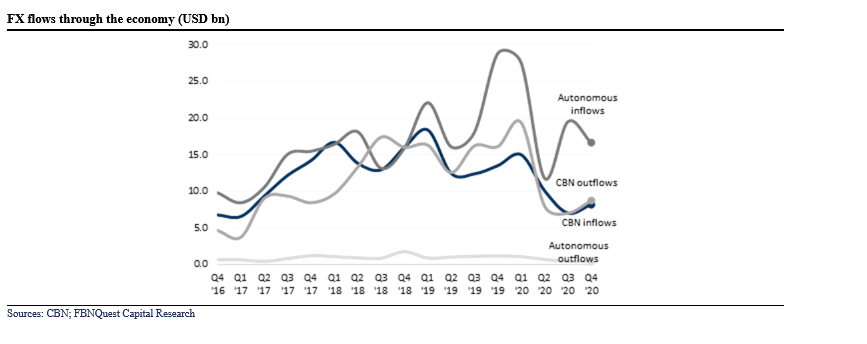
By Tunde Abidoye
Nigeria is still battling with foreign exchange (FX) inflows despite efforts by the Central Bank of Nigeria (CBN) to boost liquidity in the space.
In its latest Quarterly Statistical Bulletin for the fourth quarter of 2020, the apex bank said the total FX inflows into the Nigerian economy in the period declined by 6.4 per cent quarter-on-quarter and 42 per cent year-on-year to $24.8 billion.
Although aggregate inflows have increased since they bottomed out to a 3-year low at the height of the pandemic, they have not recovered to pre-COVID levels.
FX inflows through the CBN increased 17.1 per cent quarter-on-quarter to $8.2 billion (or 33 per cent of total inflows), thanks to a 48 per cent quarter-on-quarter rise in non-oil receipts to $6.8 billion.
A $2.0 billion category titled others including FGN loans underpinned the increase in non-oil receipts. On a net basis, the CBN’s swap arrangements grew 117 per cent quarter-on-quarter to $792 million.
In contrast, oil receipts fell 44 per cent quarter-on-quarter to $1.3 billion due to i) Nigeria’s adherence to its OPEC oil production quota, which resulted in a decline of 0.1 million barrels per day and, ii) a decrease in NNPC’s share of oil and gas exports.
Autonomous sources (other than the CBN) contributed $16.6 billion in forex inflows or 67 per cent of overall inflows. It was supported by a 10 per cent increase in over-the-counter (OTC) purchases (under invisible transactions), which included capital imports, home remittances, and other OTC purchases which we reckon are mostly linked to bonds.
A further breakdown of OTC purchases showed that capital imports and home remittances shrunk by 25 per cent quarter-on-quarter and 52 per cent quarter-on-quarter respectively.
The drop in capital imports can be attributed to Foreign Portfolio Investors (FPIs’) waning appetite after a worsening of FX liquidity, induced by a sell-off in oil prices as the pandemic worsened. Remittances also suffered a blow from the weak economic growth and employment levels in migrant-hosting countries.
Drawing from a different data series, we note that workers remittances in the balance of payments accounts which provides a more holistic view of remittances also slumped by 31 per cent quarter-on-quarter to $4 billion in Q4 ’20 and 28 per cent year-on-year to $17 billion in FY ’20.
In an effort to boost remittances, the CBN in December 2020 said beneficiaries could take their remittances from licensed International Money Transfer Operators (IMTOs) in US dollars. It also increased the number of authorized IMTOs.
In March 2021, the bank followed this up by launching its Naira 4 Dollar Scheme. Under the scheme, diaspora remittance recipients are rewarded with an extra N5 for every dollar wired through official routes.
FX outflows through the economy increased by 24.1 per cent quarter-on-quarter to $9.2 billion. About 97 per cent of total outflows were routed through the CBN.
The strong increase in forex outflows reflects a rise in CBN FX interventions at multiple intervention windows, notably the restart of FX sales to bureaux de change operators and at the investors and exporters (I&E) window in August ’20 after a five-month hiatus.
Despite the increase in outflows during the quarter, FX outflows remain below pre-pandemic levels, due largely to the CBN’s import compression strategies.
FBNQuest Researchs’ conversations with FPIs and domestic investors indicate that greater FX liberalisation (including further adjustments to the FX rate) and the loosening of FX controls such as the CBN’s 42-item FX restriction list are prerequisites to open the tap of portfolio flows.
Tunde Abidoye is the Head of Equity Research at FBNQuest. Additional information by Business Post
Economy
Food Concepts Return NASD OTC Exchange to Danger Zone

By Adedapo Adesanya
Food Concepts Plc neutralized the gains recorded by three securities, returning the NASD Over-the-Counter (OTC) Securities Exchange into the negative territory with a 0.27 per cent loss on Thursday, December 4.
Yesterday, the share price of the parent company of Chicken Republic and PieXpress declined by 34 Kobo to sell at N3.15 per unit compared with the previous day’s N3.49 per unit.
This shrank the market capitalisation of the OTC bourse by N5.72 billion to N2.136 billion from N2.142 trillion and weakened the NASD Unlisted Security Index (NSI) by 9.57 points to 3,571.53 points from 3,581.10 points.
Business Post reports that Central Securities Clearing System (CSCS) Plc went down by 50 Kobo to N38.50 per share from N38.00 per share, FrieslandCampina Wamco Nigeria Plc gained 29 Kobo to sell at N55.79 per unit versus N55.50 per unit, and Geo-Fluids Plc added 5 Kobo to close at N4.60 per share compared with Wednesday’s closing price of N4.55 per share.
Trading data indicated that the volume of securities recorded at the session surged by 6,885.3 per cent to 4.3 million units from the 61,570 units posted a day earlier, the value of securities increased by 10,301.7 per cent to N947.2 million from N3.3 million, and the number of deals went up by 146.7 per cent to 37 deals from the 15 deals achieved in the previous trading session.
At the close of business, Infrastructure Credit Guarantee Company (InfraCredit) Plc was the most traded stock by value on a year-to-date basis with the sale of 5.8 billion units for N16.4 billion, trailed by Okitipupa Plc with 170.4 million units worth N8.0 billion, and Air Liquide Plc with 507.5 million units valued at N4.2 billion.
InfraCredit Plc also finished the session as the most traded stock by volume on a year-to-date basis with 5.8 billion units transacted for N16.4 billion, followed by Industrial and General Insurance (IGI) Plc with 1.2 billion units sold for N420.2 million, and Impresit Bakolori Plc with 536.9 million units traded for N524.9 million.
Economy
Investors Gain N97bn from Local Equity Market
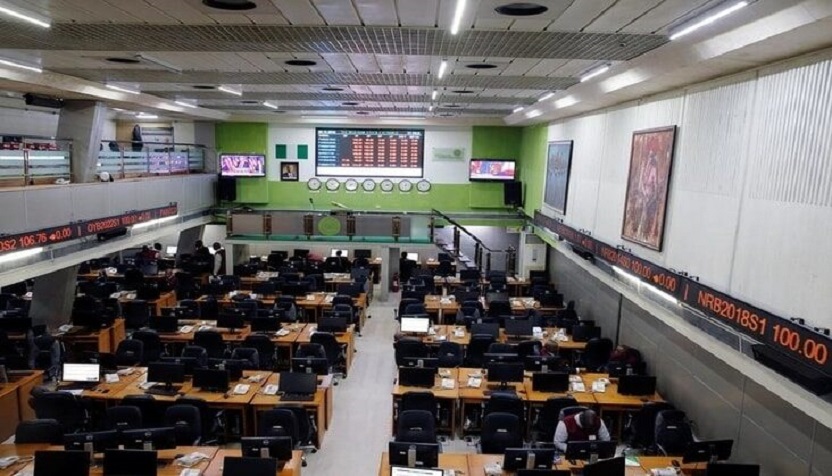
By Dipo Olowookere
The upward trend witnessed at the Nigerian Exchange (NGX) Limited in recent sessions continued on Thursday as it further improved by 0.10 per cent.
This was despite investor sentiment turning bearish after the local equity market ended with 23 price gainers and 28 price gainers, indicating a negative market breadth index.
UAC Nigeria gained 10.00 per cent to finish at N88.00, Morison Industries appreciated by 9.94 per cent to N3.54, Ecobank rose by 8.53 per cent to N36.90, and Coronation Insurance grew by 8.47 per cent to N2.56.
On the flip side, Ellah Lakes depreciated by 10.00 per cent to N13.14, Eunisell Nigeria also shed 10.00 per cent to finish at N72.90, Transcorp Hotels slipped by 9.95 per cent to N157.50, Omatek shrank by 9.23 per cent to N1.18, and Guinea Insurance dipped by 8.46 per cent to N1.19.
Yesterday, the All-Share Index (ASI) went up by 152.28 points to 145,476.15 points from 145,323.87 points and the market capitalisation chalked up N97 billion to finish at N92.726 trillion compared with the previous day’s N92.629 trillion.
Customs Street was bubbling with activities on Thursday, though the trading volume and value slightly went down, according to data.
A total of 1.9 billion stocks worth N19.2 billion exchanged hands in 23,369 deals during the session versus the N2.3 billion valued at N21.0 billion traded in 21,513 deals a day earlier.
This showed that the number of deals increased by 8.63 per cent, the volume of transactions depleted by 17.39 per cent, and the value of trades decreased by 8.57 per cent.
For another trading day, eTranzact led the activity chart with 1.6 billion units sold for N6.4 billion, Fidelity Bank traded 31.0 million units worth N589.3 million, GTCO exchanged 28.3 million units valued at N2.5 billion, Zenith Bank transacted 27.1 million units for N1.6 billion, and Ecobank traded 21.9 million units worth N744.3 million.
Economy
Naira Loses 18 Kobo Against Dollar at Official Market, N5 at Black Market

By Adedapo Adesanya
The Naira marginally depreciated against the United States Dollar in the Nigerian Autonomous Foreign Exchange Market (NAFEM) on Thursday, December 4 amid renewed forex pressure associated with December.
At the official market yesterday, the Nigerian currency lost 0.01 per cent or 18 Kobo against the Dollar to close at N1,447.83/$1 compared with the previous day’s N1,447.65/$1.
It was not a different scenario with the local currency in the same market segment against the Pound Sterling as it further shed N15.43 to sell for N1,930.97/£1 versus Wednesday’s closing price of N1,925.08/£1 and declined against the Euro by 20 Kobo to finish at N1,688.74/€1 compared with the preceding session’s N1,688.54/€1.
Similarly, the Nigerian Naira lost N5 against the greenback in the black market to quote at N1,465/$1 compared with the previous day’s value of N1,460/$1 but closed flat against the Dollar at the GTBank FX counter at N1,453/$1.
Fluctuations in trading range is expected to continue during the festive season as traders expect the Nigerian currency to be stable, supported by intervention s by to the Central Bank of Nigeria (CBN)in the face of steady dollar demand.
Support is also expected in coming weeks as seasonal activities, particularly the stylised “Detty December” festivities, will see inflows that will give the Naira a boost after it depreciated mildly last month, according to a new report.
“As the festive Detty December season intensifies, inbound travel, tourism spending, and diaspora inflows are expected to provide moderate support for FX liquidity,” analysts at the research unit of FMDA said in its latest monthly report for November.
Traders cited by Reuters expect that the Naira will trade within a band of N1,443-N1,450 next week, buoyed by improved FX interventions by the apex bank.
Meanwhile, the crypto market was down as the US Federal Reserve’s preferred inflation gauge, core PCE, likely rose in September—moving in the wrong direction. However, volatility indices show no signs of major turbulence.
If the actual figure matches estimates, it would mark 55 straight months of inflation above the US central bank’s 2 per cent target. The sticky inflation would strengthen the hawkish policymakers, who are in favour of slower rate cuts.
Ripple (XRP) depreciated by 4.5 per cent to $2.08, Solana (SOL) went down by 3.8 per cent to $138.11, Litecoin (LTC) shrank by 3.1 per cent to $83.23, Dogecoin (DOGE) slid by 2.5 per cent to $0.1463, Cardano (ADA) declined by 2.1 per cent to $0.4368, Bitcoin (BTC) fell by 0.9 per cent to $91,975.45, Binance Coin (BNB) crumbled by 0.9 per cent to $899.41, and Ethereum (ETH) dropped by 0.7 per cent to $3,156.44, while the US Dollar Tether (USDT) and the US Dollar Coin (USDC) closed flat at $1.00 apiece.
-

 Feature/OPED6 years ago
Feature/OPED6 years agoDavos was Different this year
-
Travel/Tourism9 years ago
Lagos Seals Western Lodge Hotel In Ikorodu
-

 Showbiz3 years ago
Showbiz3 years agoEstranged Lover Releases Videos of Empress Njamah Bathing
-

 Banking7 years ago
Banking7 years agoSort Codes of GTBank Branches in Nigeria
-

 Economy2 years ago
Economy2 years agoSubsidy Removal: CNG at N130 Per Litre Cheaper Than Petrol—IPMAN
-

 Banking3 years ago
Banking3 years agoFirst Bank Announces Planned Downtime
-

 Banking3 years ago
Banking3 years agoSort Codes of UBA Branches in Nigeria
-

 Sports3 years ago
Sports3 years agoHighest Paid Nigerian Footballer – How Much Do Nigerian Footballers Earn






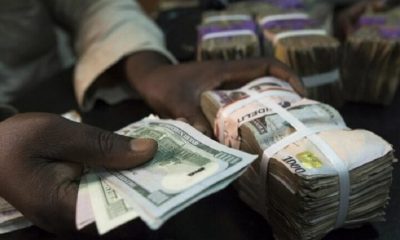


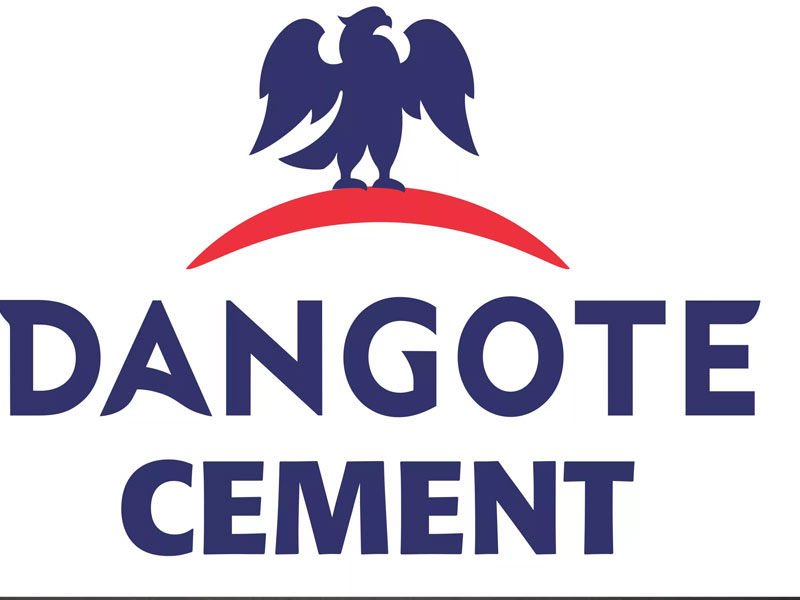
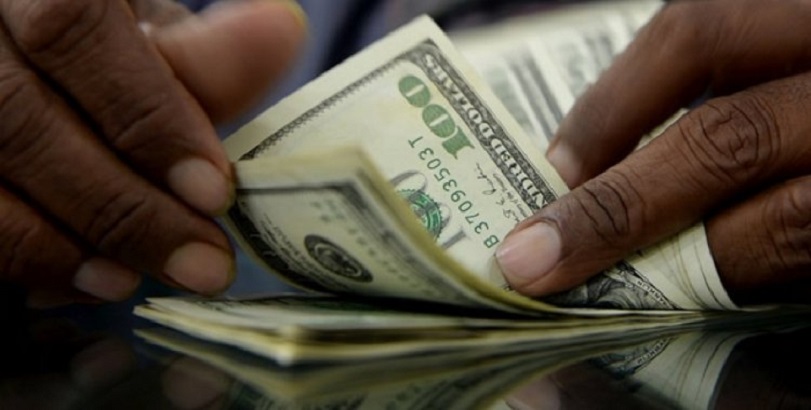











1 Comment